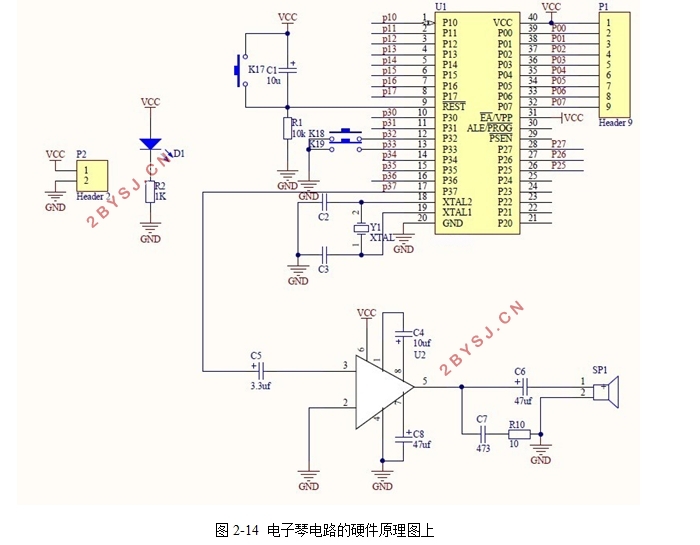电子琴的设计(AT89S52单片机)
无需注册登录,支付后按照提示操作即可获取该资料.
电子琴的设计(AT89S52单片机)(任务书,开题报告,论文17000字)
摘 要
随着计算机在社会各领域的渗透,单片机的应用正在不断地走向深入,同时带动着工业、农业、商业、家电以及玩具的日新月异,极大地提高了电子电路及系统设计质量和效率。电子琴是现代电子科技与音乐结合的产物,是一种新型的键盘乐器,它在现代音乐扮演着重要的角色。
本文主要是用AT89S52单片机为核心控制元件,设计一个简易电子琴。简易电子琴主要包括以单片机为核心的主控模块、键盘模块、显示模块和发声模块等。电子琴设有18个按键和扬声器,可以通过LCD液晶屏显示当前演奏的音符,能自动播放预先存储在单片机里的歌曲,并能自主弹奏。
软件和硬件的连调表明,本文设计的电路能够实现乐曲演奏,可以自行弹奏高中低的16个音符,并且在液晶显示器上能够显示相应的音符;具有硬件电路简单,软件功能完善,控制系统可靠,性价比较高等优点,具有一定的实用和参考价值。
关键词: AT89S52 单片机 音乐 液晶显示
Design and Implementation of Electronic Organs
Abstract
With the computer penetration in all areas of society, SCM applications are constantly deepening, while driving the industrial, agricultural, commercial, household appliances and toys with each passing day, greatly enhancing the electronic circuit and system design quality and efficiency. Keyboard is a modern electronic technology and music combined with the product, is a new type of keyboard instrument, it is in modern music plays an important role.
This article is mainly used AT89S52 microcontroller as the core control elements, design a simple flower. Simple keyboard includes a microcontroller as the core of the control module, keyboard module, display module and the sound module. Keyboard has 18 keys and speakers, LCD screen can display notes currently being played, can automatically play pre-stored in the microcontroller's songs, and can play independently.
Software and hardware, even tone that the designed circuit can achieve music playing, you can make low high school play 16 notes, and can be displayed on the LCD monitor corresponding note; simple circuit with hardware, software, perfect function, the control system reliable, high cost, etc., has some practical and reference value.
Key Words: AT89S52 microcontroller; music; LCD


目 录
摘 要 I
Abstract II
第一章 绪论 1
1.1 前言 1
1.2 电子琴的研究现状 1
1.2.1 基于FPGA的电子琴实现方式 1
1.2.2 基于CPLD的电子琴实现方式 2
1.2.3 基于单片机电子琴的实现方式 3
1.3 本文的主要工作和安排 4
第二章 电子琴的硬件设计 5
2.1 电子琴的总体方案与硬件总体结构 5
2.1.1 方案的选择 5
2.1.2 硬件总体结构 5
2.2 主控制模块 6
2.2.1 主控制模块的功能与主控单片机的选择 6
2.2.2 主控单片机AT89S52的管脚功能 6
2.2.3 主控模块的电路设计 8
2.3 按键模块 9
2.3.1 按键模块的功能与选择 9
2.3.2 4×4矩阵键盘的结构与工作原理 11
2.3.3 按键识别 12
2.3.4 按键模块的电路 12
2.4 显示模块 13
2.4.1 显示模块的功能与器件选择 13
2.4.2 LCD1602的工作原理、特点与管脚功能 14
2.4.3 显示模块的电路 16
2.5 发声模块 17
2.5.1 发声模块的功能与器件选择 17
2.5.2 发声模块的结构和原理 17
2.5.3 发声模块的电路 20
2.6 电子琴电路的硬件原理图 21
第三章 电子琴的软件设计 23
3.1 系统软件总体方案 23
3.2 主控模块的程序设计 24
3.3 按键模块的程序设计 25
3.4 液晶显示模块的程序设计 28
3.5 发声模块的程序设计 30
3.5.1 产生音乐的原理 30
3.5.2 发生模块的程序设计 32
第四章 系统的仿真与调试 36
4.1 软件仿真 36
4.1.1 Protus简介 36
4.1.2 keil简介 36
4.1.3 Protues与Keil进行仿真 36
4.2 系统硬件调试 37
第五章 总结与展望 39
5.1 总结 39
5.2 展望 39
参考文献 40
致谢 42
